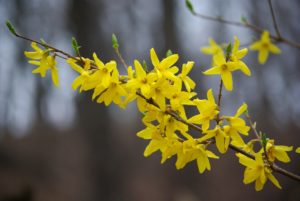
The Art and Science of Pruning Spring-Flowering Shrubs
Forsythias, one of spring’s most welcomed blooming shrubs, could use a good pruning right about now.
By Thomas Christopher
To me, the deciduous, spring-blooming shrubs are one of the greatest gifts of the gardening year. After all, they provide so much color in return for so little care, and during a season when, emerging from winter’s bleakness, we are particularly hungry for color.
Nothing, though, comes entirely without cost, and if you want your forsythias, azaleas, lilacs, and viburnums to bloom as well next year as they did this one, you have to give them a little attention with the pruning shears right about now.
Timing is important when it comes to pruning these shrubs, as well as other spring bloomers such as mock oranges, ninebarks, quinces and the bridal wreath spiraeas (Spiraea prunifolia and S. x vanhouttei). All of these spring-bloomers flower from buds produced the preceding year. As the old-time gardeners put it, they bloom on the “old wood;” that is, the flowers are borne on branches that are at least a year old.
What this means in practical terms is that if you prune these shrubs in early spring, before they flower, you will be cutting off the flower buds before they have a chance to open. Likewise, if you cut them back in fall, you’ll be removing the next spring’s crop of flowers. That’s why it’s important to prune them in spring right after they have flowered, so that you leave them plenty of time to make new growth with new flower buds during the summer’s growing season. That will leave them primed to bloom next spring. Indeed, because pruning encourages vigorous new growth, the kind of growth that bears the most flowers, treating them this way will promote the best possible show.
How do you prune these shrubs? Begin by removing the three D’s: any dead, damaged or diseased branches.
The next step depends on the species of shrub you are dealing with and its natural pattern of growth. Shrubs such forsythias or lilacs that spread by suckering, sending up an abundance of shoots from the ground, will likely benefit from thinning. If the cluster of shoots has become crowded, remove up to a third, cutting them back to the ground, to open up the shrub so that light and air can penetrate to the center. That’s healthier for the shrub and looks better, too. Be sure, while you are doing this, to take a couple of the oldest, thickest stems. These older stems typically bloom less than young ones, so this sort of “renewal pruning” will not only keep the shrub vigorous, it will enhance the floral display. In general, pruning of these multi-stemmed shrubs should be calculated to enhance their natural, vase-shaped form.
For shrubs such as quinces or azaleas that grow in a scaffold of branches borne on a couple of trunks, the recommended treatment is somewhat different. Begin with the three D’s, then remove any side branches that are growing back in toward the center of the shrub, cutting them off where they emerge from a trunk or major limb. If two branches are rubbing against each other, remove the weaker one, again cutting it off where it emerges from a trunk or major limb. If the shrub is densely branched and crowded, remove enough branches to give it a more open, and spreading form.
All of this cutting should be done with a sharp pair of scissor-like “bypass” pruners, with heavier branches or stems removed by long-handled lopping shears or a pruning saw. Hedge trimmers should not be used except on formal, sheared hedges. In other applications the use of hedge trimmers spoils the natural shape of the shrubs, reducing them to characterless spheres or mounds. In addition, by cutting all the branches back to the same length, they encourage dense, twiggy regrowth around the shrub’s outside that shades out the interior and reduces bloom.
Above all, don’t be intimidated by the pruning process. The goal is to promote an open, outward-reaching shrub. If you manage this and take care to cut the selected branches back to the base, leaving no stubs, you’ll do fine. Your shrubs, meanwhile, will appreciate the care and respond with an enhanced display the following spring.
Thomas Christopher is the co-author of “Garden Revolution” (Timber Press, 2016) and is a volunteer at Berkshire Botanical Garden. berkshirebotanical.org
Be-a-Better-Gardener is a community service of Berkshire Botanical Garden, one of the nation’s oldest botanical gardens in Stockbridge, MA. Its mission to provide knowledge of gardening and the environment through 25 display gardens and a diverse range of classes informs and inspires thousands of students and visitors on horticultural topics every year. Thomas Christopher is the co-author of Garden Revolution (Timber press, 2016) and is a volunteer at Berkshire Botanical Garden. berkshirebotanical.org.



